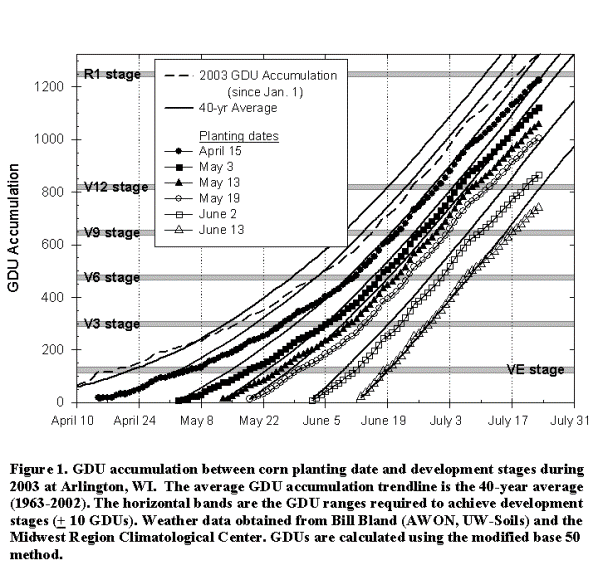
Tracking Corn Growth and Development: Making Plans for Harvest
July 24, 2003 10(12):132-133
Joe Lauer, Corn Agronomist
Over the last two weeks, GDU accumulation has slowed again compared to the 40-yr
average (Figure 1). This will continue to impact plants not at the silking stage
(R1). In the study we have been following this season, one of the two hybrids planted
on April 15 was at the R1 stage (50% silking) on July 21. This hybrid is 95-day
relative maturity and typically will silk earlier than the other 106-day RM hybrid
used in the study by producing fewer leaves (19 v. 21). The number of leaves that
eventually form accounts for the growth and development differences between full-
and shorter-season hybrids when planted on the same day. Formation of fewer leaves
leads to earlier silking dates. After silking, GDU accumulation rate becomes less
important since physiological maturity (R6 - "black layer") requires about
55 to 60 days of grain filling regardless of maturity.
Over the next few weeks many fields will be going through the tasseling stage (VT).
Watch how these fields tassel and note areas that are significantly behind in development
(more than 5-7 days). These areas will likely be behind at harvest as well. The
order in which fields tassel can also be used to predict the likely order your fields
will be harvested. Final checks need to be made at harvest to verify grain condition.
Other factors, i.e. European corn borer pressure, may force you to harvest a field
earlier in the queue.
Note silking (R1) and record the date. Typically silking occurs 1 to 3 days after
the tassels emerge. Silking date is the first indicator for predicting date of harvest
for grain or silage uses. The dent (R5) stage occurs 35-42 days after silking and
black layer formation (R6) occurs 55-60 days after silking. Usually silage harvest
begins shortly after half-milkline on the kernels. The half-milkline stage occurs
about 13 days prior to black-layer (Wiersma et al., 1993). Thus, the predicted start
date of silage harvest (half-milkline) occurs 42-47 days after silking. These predicted
start dates for silage harvest can be relayed to custom choppers if silking date
is known, so they can begin to schedule their workloads for the coming fall. Further
refinement of predicted harvest dates can be made once the milkline begins to move
and a final check can be made 2 to 3 days prior to harvest.
